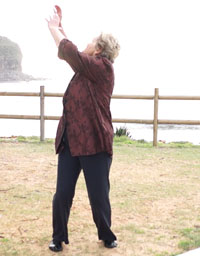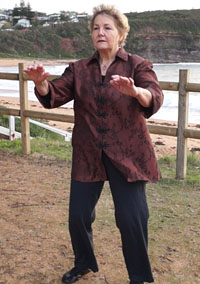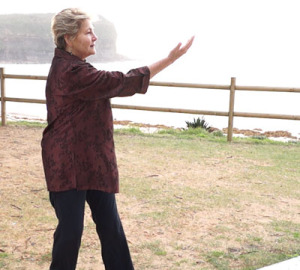What does Shibashi Qigong really mean?
In modern days, it has come to mean a practice of 18 movements that encourages Qi development and harmony within the body. One of the best Qigong routines I teach to help patients manage their lymphoedema. This routine is uncomplicated and most people can master the easy movements within a week.
The 18 movement Shibashi routine
Always start with the warm up.
You can do the full set of 18 movements (this is best) or choose the ones you prefer.
- Preparation posture – raising the arms
- Opening the chest
- Painting the rainbow
- Parting the clouds
- Rolling the arms in horse riding stance
- Rowing the boat across the lake
- Holding a ball in front of the shoulders
- Gazing at the moon
- Turning at the waist and pushing with the palms
- Cloud hands
- Scooping up the sea and looking at the horizon
- Pushing the waves
- Flying dove spreads its wings
- Punching in horse riding stance
- The flying wild goose
- Rotating the spinning wheel
- Bouncing a ball whilst stepping
- Calming Qi.
Closing position is holding your “ball” of Qi in Dan Tien.
Begin with 15 minutes a day working up to 30 minutes twice a day.
Enriching the three treasures
This routine enriches the “three treasures” (San Bao):
- Qi or “life force” – enables function / energy body
- Jing or ” vital essence” – determines substance / physical body
- Shen or “Mind” – creates intention / consciousness.
Other benefits from daily practice include:
- The earth element within you will be strengthened. Being fully grounded is the centre of your existence in every way.
- You will feel well supported and able to support others.
- Your digestive system will be robust.
- Your thinking will be clearer.
- You will have better visceral and muscular tone.
- You will have greater energy uptake, due to stronger polarity between your heaven and earth Qi.
- Better lubricated joints will help inhibit osteoarthritis and degeneration in your joints.
- You will enjoy greater emotional equanimity.
- The sequence helps protect and maintain the quality of your Jing (vital essence), thus extending length and quality of your life.
- It strengthens your kidneys, because that is where the Jing is rooted and stored.
- Your Shen (mind) will be kept strong, so that you can sustain concentration without being distracted.
- It naturally encourages more efficient circulation of Qi.
- Shibashi increases your lymphatic flow, boosting the immune system.

swivel at the waist as you gaze behind you at the moon between your hands
What you might notice
- If you are healthy before you start, you will become healthier
- If you are ill before you start, you will begin to feel better
Time of day to practice
You can do Qigong any time of day or night!
Where to practice?
The best places are where the heaven and earth Qi are most abundant and free of atmospheric pollution, such as:
- mountain tops where frenetic hustle and bustle of civilisation are absent
- next to a waterfall
- under trees
- next to a lake
- at the seashore
- alongside an unpolluted river.
If you don’t have a suitable spot outside or in nature, there are many other places you can practice. Find a quiet, peaceful space with fresh air, but not in a draught.
Stay well away from traffic fumes, excessive noise and electromagnetic radiation from TV sets, computers etc .
What direction do you face?
- In the morning, face the sun to absorb Heaven Qi as the sun rises.
- In winter, have your back to the sun to warm your kidneys.
- If you are indoors face the light.
- If you are the beach or overlooking an open view, face straight out to the horizon.
If you are considering a specific organ:
- facing east may strengthen a weak liver and help sedate tight and congested lungs
- facing west may help sedate an overactive liver and strengthen weak lungs
- facing north may help strengthen weak kidneys
- facing south may help strengthen a weak heart.
Tip
When doing Shibashi, it is not about going through the motions to get it finished. It is about focusing on your practice.
Click this link to start your Qigong practise today with your basic DVD and practice anywhere anytime in the comfort of your home.
“Qigong movement should follow the relaxed breath. The breath should never chase the movements.”
Jim Charmey, The Theory and Practice of Taiji Qigong
For full understanding of the basics of Qigong practice, buy your DVD today


